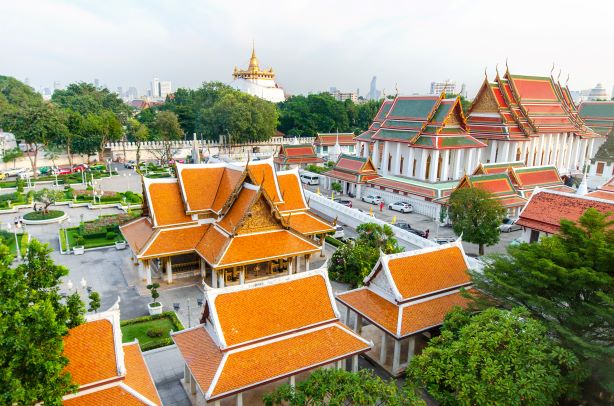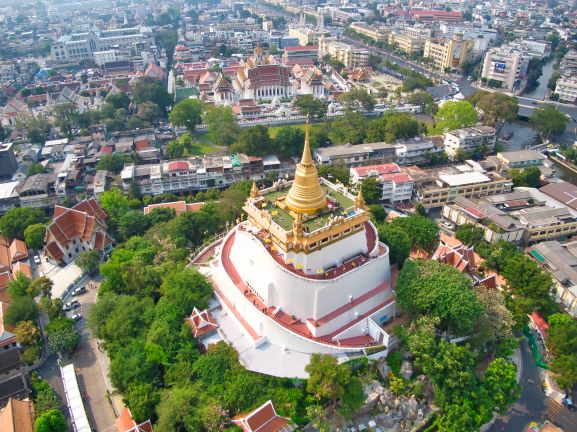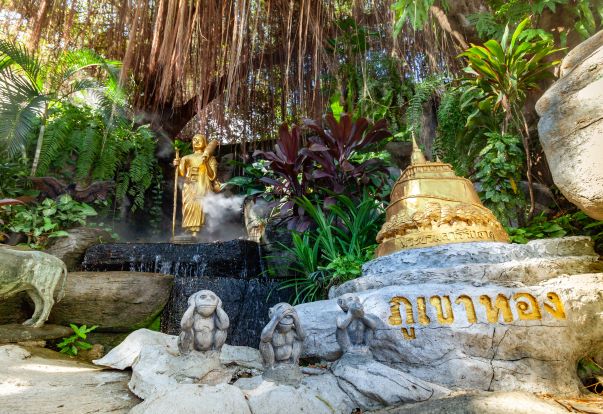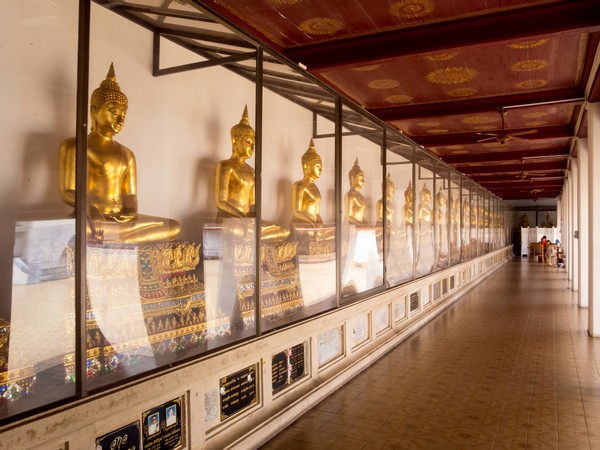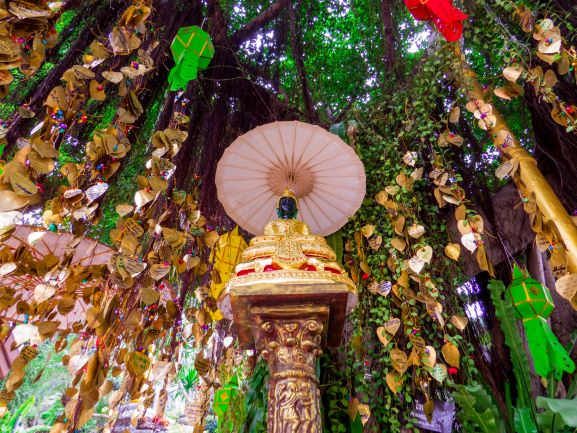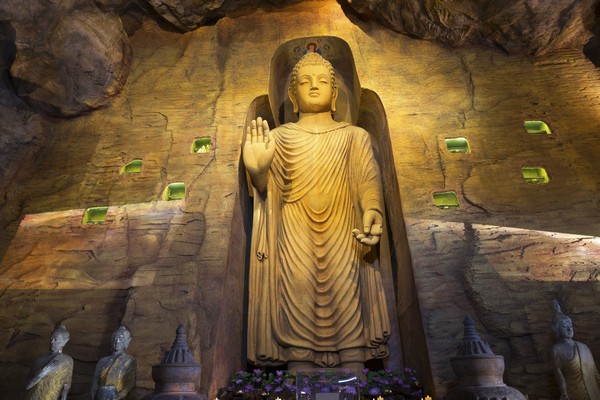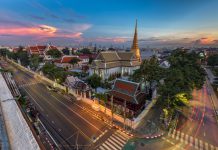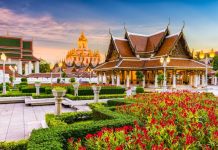
Conquer the peak of the Golden Mountain of Bangkok at Wat Saket
Wat Saket Ratcha Wora Vihara or also called in short “Wat Saket” locates aside of Mahanak Canal and Rob Krung Canal in Prom Prab Satru Phai district in Bangkok metropolis. Wat Saket is the highest grade of the second-class royal monastery with lots of significant structures within the complex. For example, Phra Borom Bunphot or Phu Khao Thong which is famous among the tourists is “the Golden Mountain”.
The Golden Mountain is a principal pagoda where to enshrine the Buddha’ relic. The elegant architecture of art of the ubosot which built in the reign of King Rama I. Interior is the fabulous fresco that was originally created in Rama III’s age and renovated in Rama VII is the Ten Jatakas or the ten last lives of the Gautama Buddha, encounter of the Demon, and Tri Bhumi (the Three Spheres). Surrounding the ordination hall are the Sema arches in the 8 directions. The arch decorated with the artistic porcelain work. Besides, it is a scripture repository from the age of Rama I and was restored in Rama III’s era and initially situated in the pool. The library is wood rounding the balcony with magnificent engraved doors and windows panels.
History of Wat Saket Ratcha Wora Vihara
According to the record by Somdej Phra Buddha Chan (Kiew Uppaseno), the former abbot of the monastery noted that Wat Saket Ratcha Wora Vihara is an ancient temple with its old name was “Wat Sa Kae”. The complex currently is the highest grade of the second-class royal monastery situated in Bangkok.
The holy site has the space connecting;
- East: it adjoins the north of Mahanak Canal and passes to Wat Chakrawat Rachawas. However, the canal exists no more.
- West: it connects to Ong Ang Canal.
- North: it adjoins to Mahanak Canal.
- South: it is a temple ditch which made from Ong Ang Canal and follows the edge of the temple to meet the east of the canal. However, the ditch already filled.
Rename to Wat Saket
The old temple, according to the mythology noted that it founded for the long time ago. It assumed that the construction might be during the Ayutthaya Era with its original name “Wat Sa Kae” and it renamed to Wat Sa Ket once King Rama I of the Rattanakosin Kingdom established Bangkok. It recorded in the royal annals that in 1783 King Rama I commanded to construct the city together with the Grand Palace and the Front Palace’s residence.
The action implemented by the collaboration of the people to dig the canals around the city from Bang Lamphu to meet the south of the river nearby Wat Chakrawat Rachathiwas. And the king also ordered to make the canal “Khlong Lord” and a large canal beyond Wat Sa Kae and named “Mahanak Canal” to set as the place for the residents to entertain with the barcarole during the rainy season as in the period of the Ayutthaya.
On the one hand, the king gave the new name to Wat Sakae to Wat Saket together with the renovation of the whole monastery complex, included the ordination hall, the monks’ living quarter, and created the canal rounded the temple, as well.
Meaning of “Saket”
About the word “Saket”, according to its definition means “wash or clean the hair”. As on the history of the temple noted that King Rama I when he was in the title “Somdet Chaophraya Maha Kasatsuek” in the regime of Thonburi Kingdom and his younger brother “Chao Phraya Surasi” moved the troops to the battle at Cambodia and once they acknowledged about Thonburi rebellion then both warlords marched the army back to the capital. In 1782, Somdet Chaophraya Maha Kasatsuek for the royal consecration ceremony at Wat Sa Kae and stayed at the temple for 3 days.
Then, he left the temple by watercourse procession to reside at Wat Photharam (currently is Wat Phra Chetuphon) and transported by the royal yacht to subdue the chaos at Thonburi Palace. And once the state is under peace, all of the noblemen invited him to be enthroned as a new king. The king, thence, graciously initiated to relocate the capital to the east of the Chao Phraya River and create the new royal palaces. Afterwards, he established Wat Phra Si Rattanasatsassadaram to enshrine the “Emerald Buddha” which is the state palladium icon. Also, the king appreciated the bell at Wat Sa Kae of which it has the most beautiful sound more than any other chime. So, he ordered to take that bell to install at the bell tower at the Temple of the Emerald Buddha, and it has located there abidingly.
Importance of Wat Saket
Wat Saket is one of the most important temples in the history of Thailand and the Chakri Dynasty from the beginning. Therefore, unsurprisingly the site appointed to be the royal monastery since the reign of King Rama I and it has been supported and renovated by the kings of the Chakri House from now and then.
The monastery complex allocated into 2 sections which are the north is the venue of “Borom Bunphot” or the Golden Mountain, Phra Uttharot’s chapel, and ubosot or the ordination hall which is all “Buddhawas”. On the other hand, in the south of the Buddhawas with the pathway to barrier the section is the dwelling of the monks and novices or so-called “Sankhawas”.
What to see in Wat Saket
Ubosot or the ordination hall
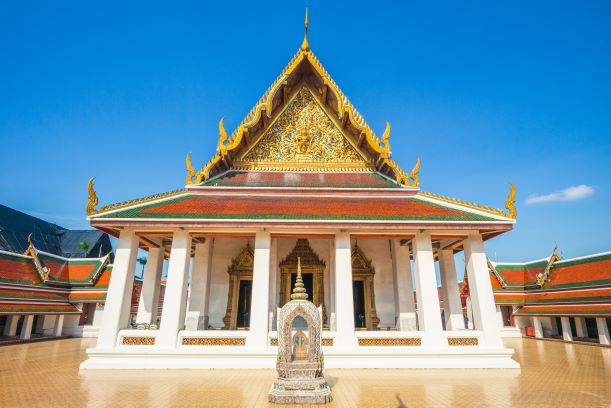
Ubosot or the ordination hall locates within the defensive wall connecting to the chapel of “Phra Uttharot”. The building surrounded with the cloister gallery with the satellite pagodas amidst the wall and the veranda.
The cloister has entrance arches in all 4 directions. Each one is the magnificent piece of art with the delicate gable apex, gable ends and roof accessories, and covered with the fine porcelain imported from China. The pediment furnished with the exquisite design ornamented with the stained glasses. Also, the 163 Buddha images located around the veranda in both moulded and stucco images. It assumed that these statues were invited to house at the temple in the age of King Rama III in the significant renovation.
The Sema Arch

All 8 directions of the ubosot are the Sema arches. The design of the Sema at Wat Saket is very delicate and beautiful, even it is appreciative by Somdet Phra Maha Samana Chao Kromma Phra Paramanuchitchinorot, the 7th Supreme Patriarch of the Rattanakosin Kingdom that “the Sema arch at Wat Saket is very magnificent and classic”.
The ordination hall with the porcelain roof and delicate roof accessories. The pediment ornamented with the coloured mosaic with the Vishnu riding on the Garuda which is the symbol of the Chakri Dynasty in the middle. The elegant edifice was built since the reign of Rama I, and then in the Rama III, the king commanded to renovate the fresco inside the ubosot. However, the painting with the craftsmanship in the Rama III was not so well; therefore it was repainted in the King Rama VII’s age.
Mural Paintings
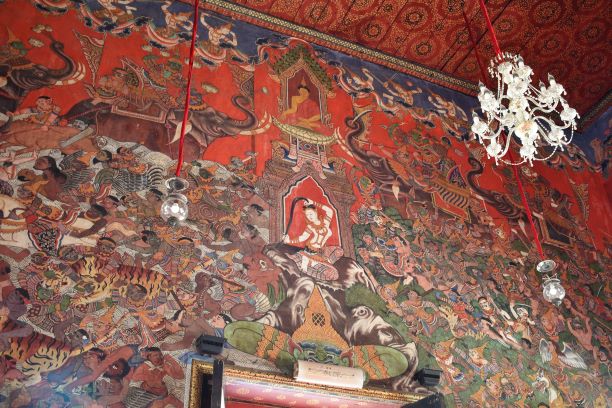
The new mural paintings are the Ten Jatakas on two sides of the wall, the upper part is celestial’s beings and the guardian deities of four realms of earth. The front wall is the subduing Buddha which is the picture of the Buddha in the meditation post in the centre and the demon Mara named “Wassade Mara Narumit” whose thousand arms with full armed riding the “Krimekhala Elephant” with the troop attacking the Buddha.
Another side is the picture of the defeated demon king with the mother earth is squeezing her hair below the Buddha’s throne as the witness of the Buddha’s meritorious acts. And last but not least, the wall behind the principal Buddha image is the painting of the Three Spheres – Heaven, Earth, and Hell. The cloister gallery, in 1958 was restored by the 15th Supreme Patriarch Somdet Phra Ariyavongsagatanana IV who was the abbot of the monastery with the cost approximately amount THB 2 million.
The Main Buddha Image inside the Ubosot

The character of the main Buddha inside the ubosot is an enormous stucco statue covered with the gold leaves in the meditation attitude. It believes that the image is the craftsmanship of the early Rattanakosin that is rare to find among the Thai craft. Nonetheless, all in all, is close to the Ayutthaya art that presents the inherited skill from the previous age. Identically, the record noted that King Rama I bestowed to plaster over the original image in which of the squared shape face (the identity of the Ayutthaya style), small knot with high radius fame, full mouth and layered robe that is similar to the art in late Ayutthaya in the King Prasart Thong’s era.
However, the distinctive point of the Rattanakosin art is the robe of the Buddha image is cross over the centre of the body, whereas the other ages the gown is on the left side of the body. The radius of the structure is 330 meters approximately 79 meters high. The Golden Mountain considered as another most significant and worshipful Buddhist sites in Thailand, also one of the most valuable properties of the nation.
Borom Banphot, the Golden Mountain
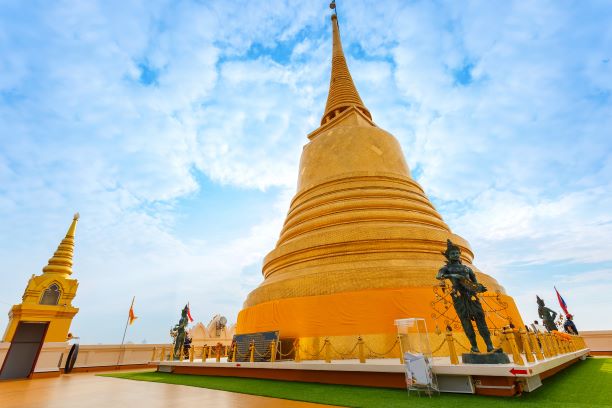
Begin in King Rama III
The creation of the Golden Mountain began in Rama III’s era with the initiation of the king to build the chedi to be like the Golden Mountain at Ayutthaya province. The Golden Mountain in Ayutthaya sited over the edge of the field as the venue for the people in the region to entertain in the annual celebration included to worship the pagoda. King Rama III considered Wat Saket is the right place to establish the Golden Mountain with its proper landscaping with canal surrounding the area as same as one at Ayutthaya. So that, the king ordered Phraya Sripipatratanarajkosa (Thut Bunnag) to be the chief of construction.
Anyhow, the land, at that period, was close to the canal resulted in soft ground that was able to resist the weight of the chedi, thence it had subsided until the construction had to pause and left only the brick structure and the building was abandoned. It named “Phra Chedi Phu Khao Thong”.
Renovated in King Mongkut
Afterwards, in the reign of King Mongkut. In 1864, the king commanded Krommamuen Mahesuan Sivavilas to be the chief of construction to build the grand mountain at the royal field of which the structure with 26 meters high included the 14-meter high pavilion in total is 40 meters to be the place to house the royal relic. Also, the affiliate pavilions in four directions to store the ashes of the Front Palace (the viceroy) and the important member of the royal family.
According to the building, King Rama IV mentioned to a grand pagoda at Wat Saket that Rama III began the structure. King Mongkut considered that it’s not supposed to abandon it like that; therefore the king ordered Phraya Sri Phiphat (Pae Bunnag) a son of Phraya Sripipatratanarajkosa (Thut Bunnag) to be the chief of building and appointed Phraya Ratchasonkram to be the chief of builder to restore the mountain-like structure and build the pagoda on the top. And then in 1865, King Mongkut presided over the laying foundation stone ceremony, and the renovation had continually processed all along his reign. The king, although the construction had not completed, renamed to “Borom Banphot” followed to the structure he ordered to built at the royal ground previously.
Completed in King Rama V
The restoration of Borom Banphot continued until it completed in the throne of Rama V. The king also ordered to cut the road “Sa Prathum” from Bumroongmueng Road, together with the creation of Mahadthai Uthis Bridge. And Boriphat Road connected from Sa Prathum Road to access Borom Banphot ground. Then, it was Chakraphat Road the king ordered to pile up the canal at the front of the temple to make a new road and wall. Moreover, the king assigned to build a bridge to cross the canal behind the monastery to access the Golden Mountain, as well.
Concludable, Borom Banphot or the Golden Mountain had taken 3 reigns of the king to be completed.
How to Get to Wat Saket
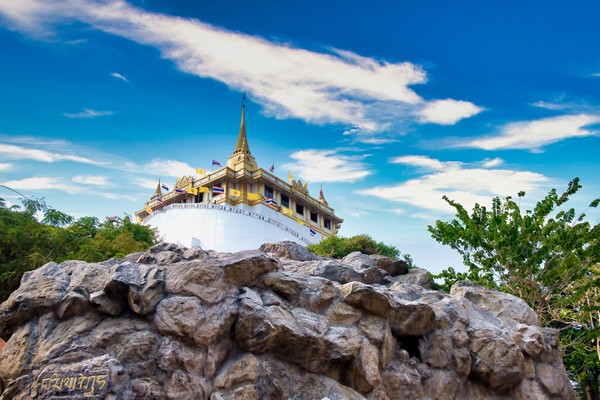
The tourist can travel to Wat Saket with various options; buses, metered taxi, and Took Took. Alternatively, another convenient option is by boat that you ashore at Phan Fa Leelas Pier (Saen Sab Canal) or Phu Khao Thong Pier (Phadung Krungkasem Canal)
Wat Saket Opening Hours
The temple opens to the visitors daily between 8.00am-7.00pm.


